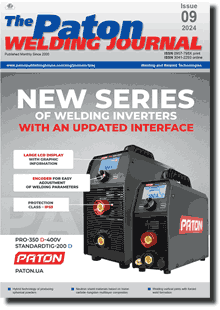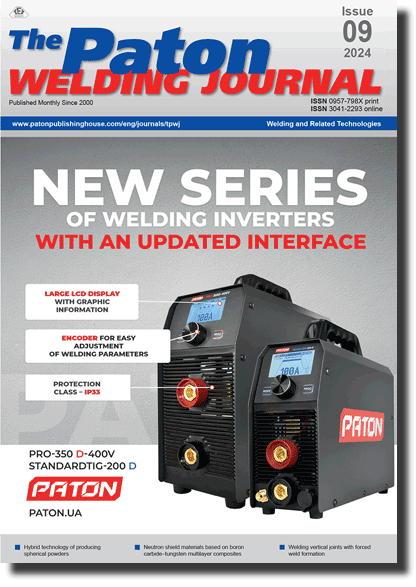| 2024 №09 (01) |
DOI of Article 10.37434/tpwj2024.09.02 |
2024 №09 (03) |

цThe Paton Welding Journal, 2024, #9, 12-19 pages
Phase and structural transformations during heating of multilayer Ti/Cu foils of eutectic composition obtained by the EBPVD method
S.O. Demchenkov, T.V. Melnychenko, A.I. Ustinov, O.E. Rudenko, O.V. Samofalov
E.O. Paton Electric Welding Institute of the NASU. 11 Kazymyr Malevych Str., 03150, Kyiv, Ukraine. E-mail: s_demchenkov@ukr.netAbstract
Phase and structural transformations in multilayer Ti/Cu foils of eutectic Composition I (Ti50‒Cu50 wt.%) and Composition II (Ti22‒Cu78 wt.%), obtained by layer-by-layer electron beam physical vapor deposition of components in vacuum, were investigated using differential thermal analysis (DTA), X-ray diffraction (XRD), and scanning electron microscopy (SEM) methods. It was found that during heating of the multilayer foils in the temperature range of 400‒600 °C, due to the diffusion interaction between Ti and Cu layers, the following intermetallic compounds are formed: Cu4Ti, Cu4Ti3, CuTi, and CuTi2 in Composition I foils, and Cu4Ti and Cu4Ti3 in Composition II foils. Upon further heating, melting of the multilayer foils of both eutectic compositions occurs. The Composition II foils begin to melt at a temperature of 879 °C, close to the equilibrium melting temperature of the eutectic alloy of the same composition (875 °C), while in the case of Composition I foils, the onset of melting occurs at a temperature of 915 °C, which is lower compared to the melting temperature of the eutectic alloy of Composition I (960 °C). Considering that Cu4Ti and Cu4Ti3 metastable phases are formed in multilayer Composition I foils, which are components of the more fusible eutectic of Composition II, the reduction in the melting temperature of the foil may be due to its metastable structure. Such behavior of multilayer Ti/Cu foil of eutectic Composition I may facilitate softening of the temperature conditions required to establish physical contact in the material bonding zone during their reactive brazing.
Keywords: Ti‒Cu alloys, eutectic, electron beam physical vapor deposition, vacuum condensates, multilayer structures, phase transformations, melting
Received: 05.03.2024
Received in revised form: 06.06.2024
Accepted: 25.09.2024
References
1. Weihs, T.P. (2014) Fabrication and characterization of reactive multilayer films and foils. Eds by K. Barmak, K. Coffey. Metallic films for electronic, optical and magnetic applications. Cambridge, Woodhead Publishing Ltd, UK, 160-243. https://doi.org/10.1533/9780857096296.1.1602. Adams, D.P. (2015) Reactive multilayers fabricated by vapor deposition: A critical review. Thin Solid Films, 576(16), 98-128. https://doi.org/10.1016/j.tsf.2014.09.042
3. Ustinov, A.I., Demchenkov, S.O. (2022) Influence of microstructure of multilayer Al/Ni foils on phase transformations initiated by heating. Suchasna Elektrometal., 1, 16-23. https://doi.org/10.37434/sem2022.01.02
4. Yupeng, Zh., Jianglong, Y., Ziyi, L. (2014) Structural view study on diamond and copper bonding with AlNi micro/nano multilayers. Rare Metal Materials and Eng., 43(11), 2597-2601. https://doi.org/10.1016/S1875-5372(15)60009-1
5. Duckham, A., Spey, S.J., Wang, J. et al. (2004) Reactive nanostructured foil used as a heat source for joining titanium. J. of Applied Physics, 96, 2336-2342. https://doi.org/10.1063/1.1769097
6. Ramos, A.S., Vieira, M.T., Simoes, S. et al. (2009) Joining of superalloys to intermetallics using nanolayers. Advanced Materials Research, 59, 225-229. https://doi.org/10.4028/www.scientific.net/AMR.59.225
7. Cao, J., Song, X.G., Wu, L.Z. et al. (2012) Characterization of Al/Ni multilayers and their application in diffusion bonding of TiAl to TiC cermet. Thin Solid Films, 520, 3528-3531. https://doi.org/10.1016/j.tsf.2012.01.001
8. Ustinov, A.I., Demchenkov, S.A. (2017) Influence of metastable Al9Ni2 phase on the sequence of phase transformations initiated by heating of Al/Ni multilayer foils produced by EBPVD method. Intermetallics, 84, 82-91. https://doi.org/10.1016/j.intermet.2017.01.005
9. Ming-Fang, W., Chan, Y., Zhi Shuie, Y., Rui Feng, L. (2005) Formation process of liquid in interface of Ti/Cu contact reaction couple. Transact. Nonferrous Metals Soc. China, 15, 125-129.
10. Kocherzhinskyi, Yu.A. et al. (1974) Experimental-equipment samples for physico-chemical analysis at high temperatures. Devices for examination of physical properties of materials. Kyiv, Naukova Dumka [in Russian].
11. Massalski, T.B., Okamoto, H., Subramanian, P.R., Kacprzak, L. (1990) Binary alloy phase diagrams. 2nd Ed. ASM International, Materials Park, Ohio, USA.
12. Zalkin, V.M. (1987) Nature of eutectic alloys and effect of contact melting. Moscow, Metallurgiya [in Russian].
13. Gladkikh, N.T., Kryshtal, A.P., Sukhov, R.V. et al. (2010) About critical thickness of contact melting in lamellar film system Au/Ge. Visnyk KhNU, series Physics, 13(914), 109- 114 [in Russian].
14. Kukushkin, S.A., Osipov, A.V. (1997) Growth, structure and morphological stability of nuclei growing from melts of eutectic composition. Fizika Tvyordogo Tela, 39(8), 1464-1469 [in Russian]. https://doi.org/10.1134/1.1130065
Suggested Citation
S.O. Demchenkov, T.V. Melnychenko, A.I. Ustinov, O.E. Rudenko, O.V. Samofalov (2024) Phase and structural transformations during heating of multilayer Ti/Cu foils of eutectic composition obtained by the EBPVD method. The Paton Welding J., 09, 12-19.The cost of subscription/purchase order journals or individual articles
| Journal/Currency | Annual Set | 1 issue printed |
1 issue |
one article |
| TPWJ/USD | 384 $ | 32 $ | 26 $ | 13 $ |
| TPWJ/EUR | 348 € | 29 € | 24 € | 12 € |
| TPWJ/UAH | 7200 UAH | 600 UAH | 600 UAH | 280 UAH |
| AS/UAH | 1800 UAH | 300 UAH | 300 UAH | 150 UAH |
| AS/USD | 192 $ | 32 $ | 26 $ | 13 $ |
| AS/EUR | 180 € | 30 € | 25 € | 12 € |
| SEM/UAH | 1200 UAH | 300 UAH | 300 UAH | 150 UAH |
| SEM/USD | 128 $ | 32 $ | 26 $ | 13 $ |
| SEM/EUR | 120 € | 30 € | 25 € | 12 € |
| TDNK/UAH | 1200 UAH | 300 UAH | 300 UAH | 150 UAH |
| TDNK/USD | 128 $ | 32 $ | 26 $ | 13 $ |
| TDNK/EUR | 120 € | 30 € | 25 € | 15 € |
AS = «Automatic Welding» - 6 issues per year;
TPWJ = «PATON WELDING JOURNAL» - 12 issues per year;
SEM = «Electrometallurgy Today» - 4 issues per year;
TDNK = «Technical Diagnostics and Non-Destructive Testing» - 4 issues per year.


